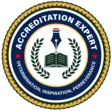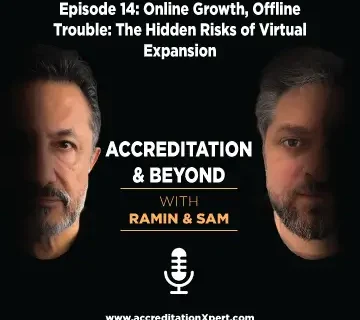
If you’re running a college or university in 2025, chances are you’ve asked this question more than once: Where did all the students go?
The higher education enrollment cliff is no longer a projection; it’s a reality. Between 2019 and 2022 alone, U.S. postsecondary enrollment dropped by over 1.2 million students, and that trend hasn’t reversed. As NCES and the National Student Clearinghouse report ongoing declines, especially among younger students, men, and community college enrollees, the pressure is mounting for institutions to act fast.
The Data Behind the Decline
According to the National Student Clearinghouse, total undergraduate enrollment in Spring 2024 sat at 14.8 million, down from over 17 million a decade ago. Here’s what we know:
- Community colleges have lost the most, nearly 37% since 2012
- Four-year private nonprofits are seeing slower but steady erosion
- Male enrollment continues to lag behind female enrollment by 10–15%
- States in the Midwest and Northeast are experiencing sharper declines due to aging populations and a decrease in the number of high school graduates.
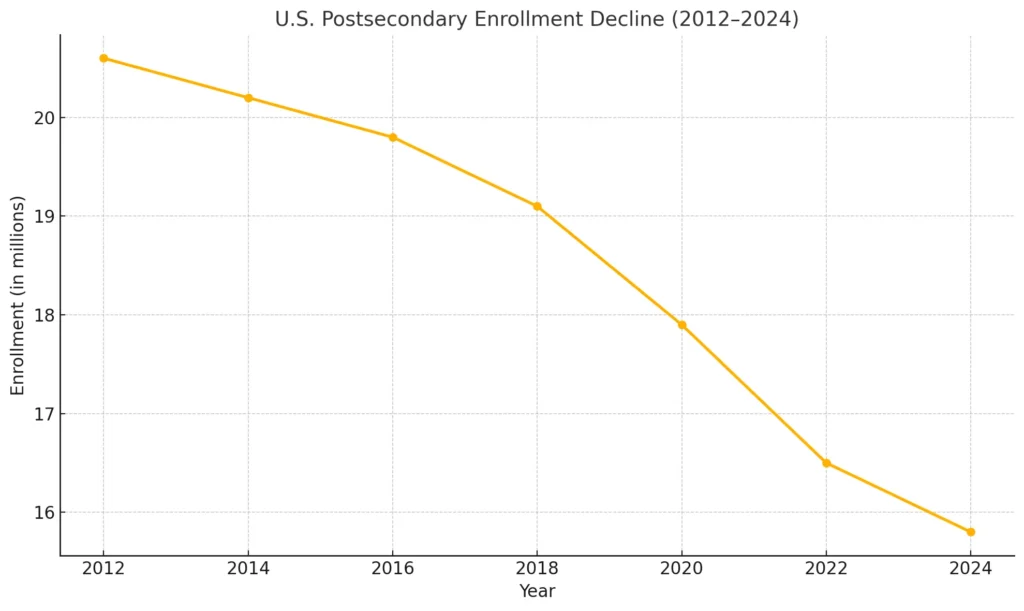
Why It’s Happening
The enrollment cliff didn’t happen overnight. It’s the result of several big forces that have slowly converged, and now they’re hitting schools all at once. One of the most significant shifts is demographic. Fewer students are graduating from high school, especially in regions like the Midwest and Northeast, where birth rates have been declining since the 2007 recession. Fewer students in the pipeline means more competition, and some institutions are already feeling the squeeze.
Then came the pandemic. COVID-19 wasn’t just a temporary disruption; it fundamentally altered how students think about education. Some deferred enrollment and never came back. Others realized they could learn or work in different ways, and the traditional college path no longer felt as essential. The result has been an uneven and unpredictable enrollment recovery that’s still playing out across the country.
Affordability is another major factor. With tuition rising and student debt still a significant burden, families are reconsidering their commitment to a four-year program. Students are asking harder questions about value: Is this worth the cost? Will this help me get a job? What am I actually paying for? These are fair questions, and they’re not going away.
And let’s not overlook how rapidly the landscape of alternatives has evolved. Boot camps, short-term credentials, microdegrees, and remote apprenticeships have all exploded in popularity because they offer faster, cheaper, and often more targeted paths to employment. Gen Z is tech-savvy, career-focused, and pragmatic. If they can learn a marketable skill in six months instead of four years, many will take that route.
This isn’t just about numbers. It’s about changing mindsets. Students are making different decisions, and institutions that want to remain relevant need to meet those students where they are: in terms of cost, flexibility, and outcomes.
The result? Fewer applicants, lower conversion rates, and increased melt, even for institutions with strong reputations.
What This Means for Accreditation and Institutional Survival
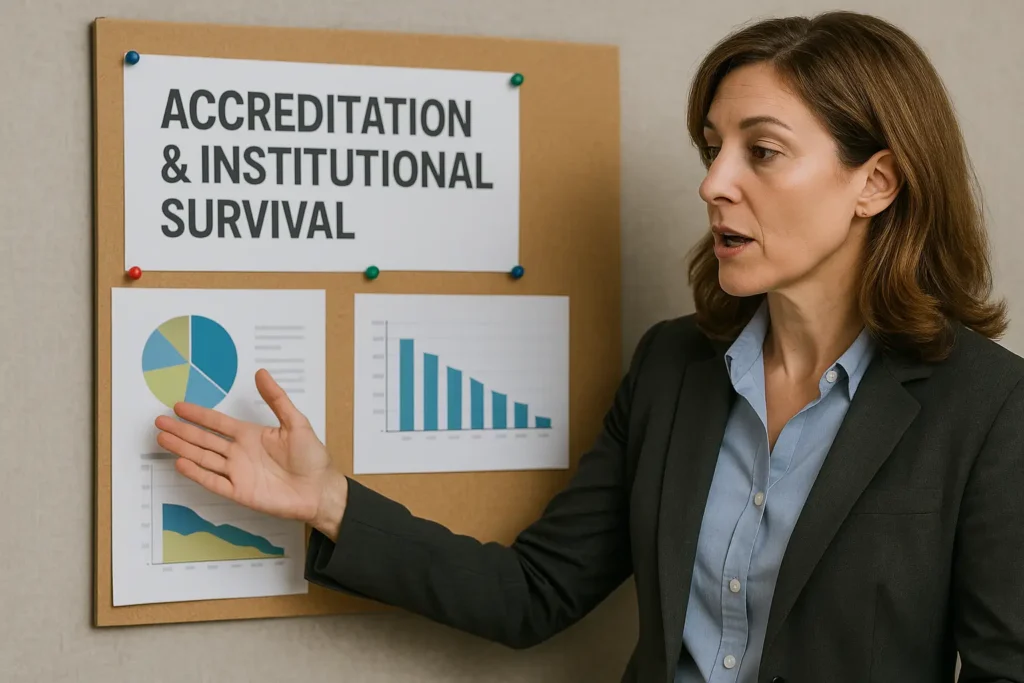
At Accreditation Expert Consulting, we’ve seen how the enrollment cliff reshapes more than just recruitment; it impacts your entire accreditation narrative. Here’s how:
- Readiness Reviews are now scrutinizing enrollment trends and stability.
- Self-studies must show how institutions are adapting to demographic and labor market shifts.
- Program Evaluations are asking whether your offerings are still relevant and outcome-based.
- Outcome Standards require more than pass rates; they demand transparent placement, retention, and graduate impact data.
One institution we worked with in 2024 experienced a 23% decline in enrollment over the preceding three years. We helped them revise their curriculum portfolio, strengthen market alignment, and prepare a candidacy response that addressed the drop head-on. They passed, with commendations.
Smart Moves for Institutions Facing Enrollment Decline
When we work with institutions experiencing enrollment decline, the first thing we say is this: don’t panic, plan. There’s a path forward, but it requires clear-eyed decision-making and a willingness to evolve. Begin by taking a thorough review of your program offerings. Which ones are underperforming? Which aligns with real workforce demand? It may be time to sunset legacy programs that no longer serve your market and double down on high-impact, skill-based certificates or short-term credentials that speak to today’s learners.
Next, modernize your delivery. Students expect flexibility. If your courses are still locked into rigid, on-campus-only formats, you’re losing out. Embrace mobile-friendly platforms, asynchronous options, and hybrid models that allow learners to engage on their own terms. It’s not just a tech upgrade, it’s an accessibility strategy.
Also, take time to revisit how you communicate value. Can a prospective student visiting your website or reading your catalog immediately understand what your programs lead to, how long they’ll take, and what they’ll cost? If not, it’s time to rethink your messaging. Today’s students are making decisions quickly and comparing options at a glance. Career outcomes, affordability, and clarity matter more than ever.
Just as importantly, lean on your data. Yield rates, persistence trends, and dropout patterns- this information isn’t just for internal dashboards. It’s a roadmap. Use it to fine-tune retention strategies, guide program changes, and support your accreditation story. Finally, whatever changes you make, document them. Accreditors aren’t just asking if you’re meeting standards. They’re asking how you’re adapting. Showing that you’re listening, analyzing, and responding is often what separates approved institutions from the ones that stall.
How Accreditation Expert Consulting Can Help
We specialize in helping institutions respond to the enrollment cliff with compliance-ready, market-aligned solutions. From curriculum redevelopment and catalog revisions to full self-study preparation and state re-approvals, we help you do more than stay accredited; we help you stay relevant.
Our approach is built on:
- Real-time labor market analysis
- Accreditation trend tracking
- Customized institutional planning
- Proven compliance strategies that withstand scrutiny
Whether you’re launching a new program, undergoing renewal, or regrouping after enrollment loss, we’re ready to partner with you.
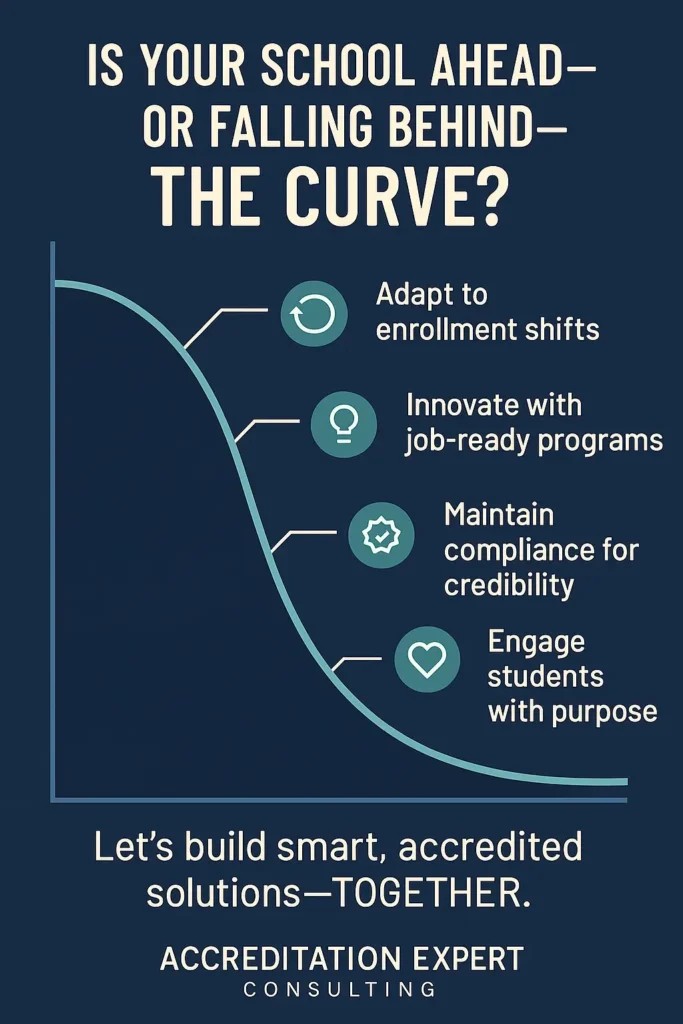
Final Thoughts
The enrollment cliff is not a temporary setback; it’s a structural shift in the way students choose, engage, and evaluate education. Institutions that respond with courage, clarity, and compliance will survive and evolve. Those who hesitate will fall further behind.
Let’s make sure your school isn’t one of them.
Contact us today for a private strategy session or download our free Accreditation Response Toolkit.
📧 info@AccreditationXpert.com
📞 1-833-232-1400
🌐 www.AccreditationXpert.com (That’s X-P-E-R-T)
What is the enrollment cliff, and when did it begin?
The enrollment cliff refers to a sharp, long-term decline in postsecondary student enrollment. It began after the 2008 financial crisis and accelerated around 2020, driven by COVID-19 and changing demographics.
How does enrollment affect accreditation?
Enrollment trends influence institutional viability, student outcome metrics, and financial projections—all of which are reviewed during accreditation.
What should I document if my school is seeing fewer students?
Track all changes: program closures or launches, marketing shifts, retention efforts, and financial planning. Tie them back to the mission and student success.
Can schools recover from enrollment loss?
Yes; many do. The key is to adapt your programs, update your delivery models, and respond quickly with a documented strategy.
How soon should we prepare for accreditation if enrollment is dropping?
Now. The earlier you plan, the more control you have over the narrative and documentation during your next review cycle.

